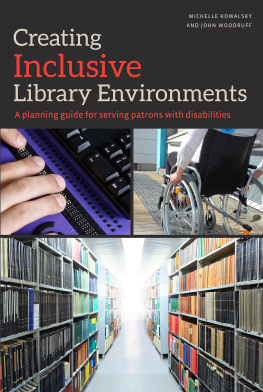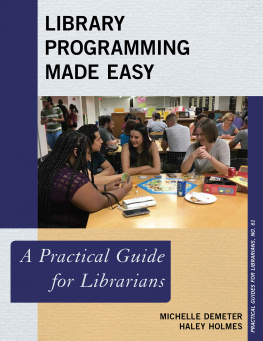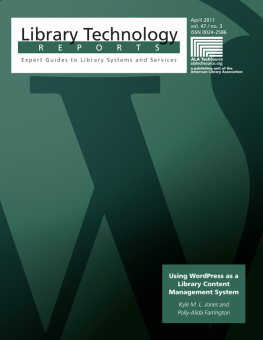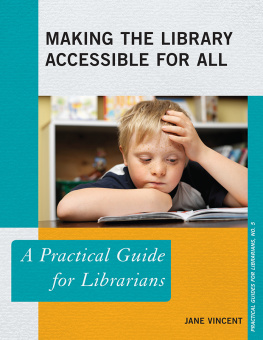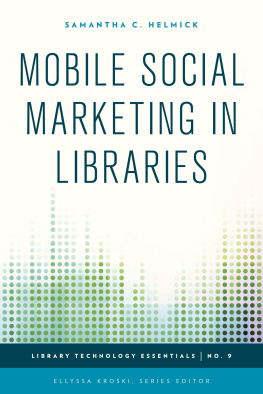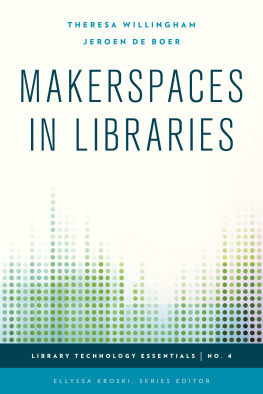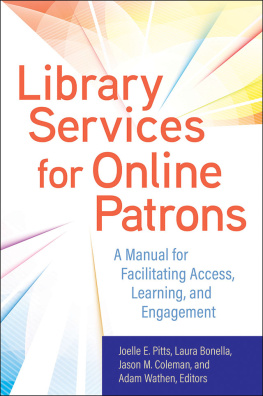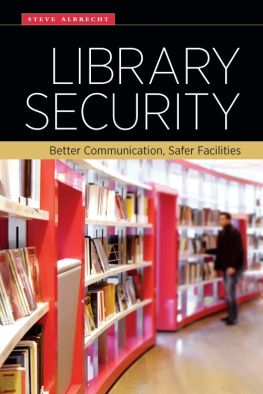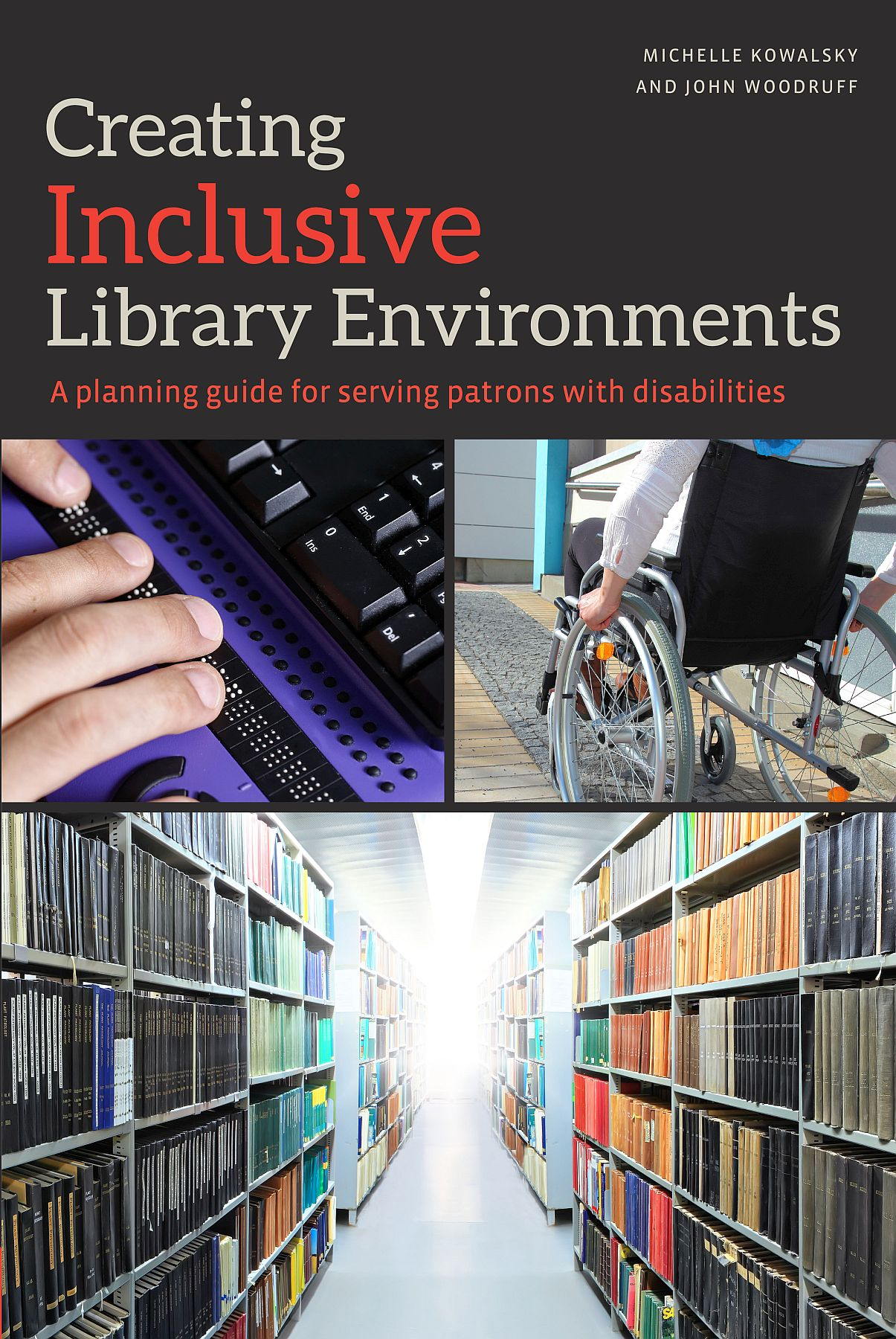
ALA Editions purchases fund advocacy, awareness, and accreditation programs for library professionals worldwide.

2017 by the American Library Association
Extensive effort has gone into ensuring the reliability of the information in this book; however, the publisher makes no warranty, express or implied, with respect to the material contained herein.
ISBNs
978-0-8389-1485-4 (paper)
978-0-8389-1487-8 (PDF)
978-0-8389-1488-5 (ePub)
978-0-8389-1489-2 (Kindle)
Library of Congress Cataloging-in-Publication Data
Names: Kowalsky, Michelle, author. | Woodruff, John, 1960 author.
Title: Creating inclusive library environments : a planning guide for serving patrons with
disabilities / Michelle Kowalsky, John Woodruff.
Description: Chicago : ALA Editions, an imprint of the American Library Association,
2017. | Includes bibliographical references and index.
Identifiers: LCCN 2016026241 | ISBN 9780838914854 (pbk. : alk. paper) | ISBN
9780838914878 (pdf) | ISBN 9780838914885 (epub) | ISBN 9780838914892 (kindle)
Subjects: LCSH: Libraries and people with disabilitiesUnited States.
Classification: LCC Z711.92.H3 K69 2016 | DDC 027.6/63dc23 LC record available at
https://lccn.loc.gov/2016026241
Cover images Shutterstock, Inc.
Contents
It is our intention to provide a road map for libraries so that they may be proactive in creating inclusive library environments. As you review the accessibility of your library, this publicationand the discussions you have about it with otherswill aid you in your quest to be truly inclusive.
A Personal Note from John
Collaborating on this project intrigued me because it combined the issue to which I have dedicated my professional lifehelping those with disabilitieswith one of the resources I have ardently utilized throughout my lifethe library.
Growing up, my frequent visits to our public library were prompted by both necessity and the pursuit of enjoyment. The need to utilize library resources for school projects was an absolute requirement. As one of nine children, I sought the many resources I needed, as well as the librarys peace and quiet, which was also not available at home. When I was old enough, I would walk the mile to our town library and become happily lost in the books and magazines. I have always loved music, so it was a revelation to me that I could check out different types of media and listen to new artists in the days when my boyhood jobs did not provide enough discretionary income to purchase these items myself.
The library continued to be my one-stop destination for information and resources throughout high school and college. Each time I entered its doors, I crossed into another world and experienced a sense of calm. When the library began offering films to rent, it became my standard practice to stock up on movies for the weekend.
Those library trips eventually included my wife and children. It was a basic part of our routine to travel to the library together and then disperse to different areas of the building to investigate whatever sparked our interest on that particular day.
An important rite of passage for both my son and my daughter was to receive their first library cards. Even back then, I smiled when I remembered one of my professors in graduate school who would require that his children do research on the location of their upcoming family vacation. This also required use of a new library at their destination, an excellent excuse to practice their skills.
Which audio book to listen to on a family drive was always a highly debated subject. And sometimes, when we had a clear winner, wed arrive at our destination still engrossed in the story and reluctant to leave the car.
Some of the joys I still have to this day are to enter a library, to browse what is new, to see what peaks my interest, and to recall why I went to the library in the first place. Im sure Im not alone in this experience. Many users visit the library with a particular goal in mind. Once that goal is achieved, they may stay longer because they have consciously or unconsciously given themselves permission to linger among the books, journals, magazines, or movies.
My professional life has focused on championing the rights of individuals with disabilities and helping businesses and organizations understand these rights. This project seemed a natural fit, considering my vocation for disability resources and my love and respect for the many services offered by libraries.
A Personal Note from Michelle
I too escaped to the library anytime being at home got boring or tedious. I rode my small, red ten-speed bicycle to the only two places I was allowedthe libraries on either side of town. It was my freedom! Even as a teenager I was clearly more out of shape than John, because a 1.5 mile ride each way tired me out for the rest of the night. Im pretty sure everyone at home actually liked it that way.
Riding eastward on the side of the road, through a slow series of traffic lights in the commercial part of downtown, I ended up at my local public library. I had just moved into town, and suddenly I needed sources for a research report for school. I was directed to the childrens room as a fifth grader, but quickly exhausted the nonfiction offerings there. It was suddenly officialI was no longer a child, and the library was my proof.
Once I had the official green reciprocal borrowing sticker on my adult library cardwhich at the time seemed more valuable than real moneyI branched out. I rode my bike westward instead, down a flat and straight but busy suburban street, to the public library of the town next door. Here I stuffed books, music, and fliers into yellow plastic bags like a crazed supermarket checker. I then attempted to ride home (never in a straight line) with the bags in one hand and handlebars in the other. Its a wonder I never got run over.
As an adult, I absolutely never ride my bike and I dont miss it one bit. But I still love my library card and I still entertain myselfafter working all day in a library, mind youby going to the public library... any and all, near, and far. If you are accompanying me at any time, you may also be asked to take my photo in front of the nearest library sign, so consider yourself forewarned.
I guess I never really knew much about disabilities until I started teaching more than twenty years ago. My K12 students had physical or learning disabilities, often accompanied by second-language challenges and personality disorders. Until then, the people with disabilities that I had encountered were patrons of the public library, customers at the supermarket, or neighbors. Suddenly it became my professional responsibility to understand them, and that was when my learning curve really accelerated.
As I grew older, my own family began to include members who have such disabilities as autism spectrum disorders, blindness, genetic and developmental disorders, physical disabilities, early-onset dementia, and speech-language impairments. While it was unusual at first to encounter these conditions because they had not been common in my family, dealing with the challenges of disabilities became a normal part of life.
I have learned from personal experience that advocacy turned into action is indeed the best way we can support others. When you truly understand, your actions speak a special kind of language that communicates your respect, empathy, and love all at once.

